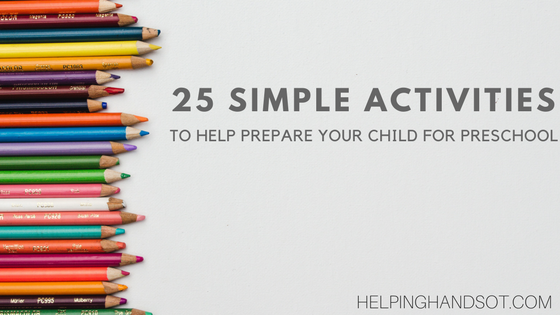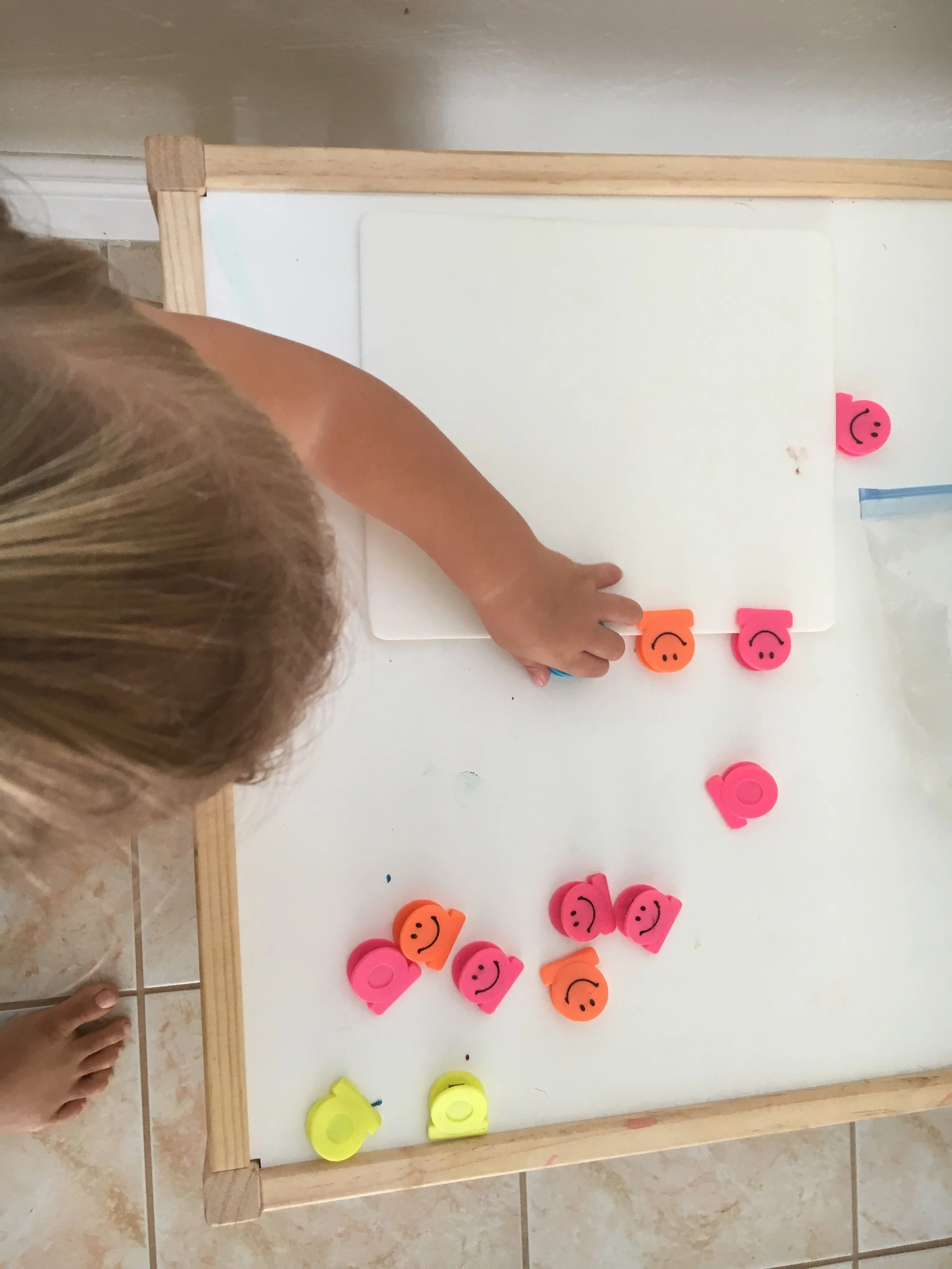25 Simple Activities to Help Prepare Your Child for Preschool
Do you remember feeling slightly anxious about whether or not your child was meeting their developmental milestones on time? Well, magnify that feeling by 1,000 and that's what it's like to be a therapist mom. Except you know what age each skill should emerge and what deficits and disabilities are out there. You end up defaulting to thinking something could be wrong with them every five minutes.
Looking back, I can see how ridiculous I was, but at the same time I can't really blame first-time-mom-therapist me.
While I do, clearly understand the first time parent angst, I can thankfully say I have done a 180 in my view of child development. I no longer worry if my child is behind on a skill or struggling with any particular activity that I know is normal for their age range. Because I know my kids are typically developing children. I truly understand, now that I am a parent, that every child IS uniquely and wonderfully different.
So please use this list as a guideline, and not something to get worked up about. Learning is not something that should be forced, but rather encouraged through fun and child-led interest.
So here we go. In honor of the start of a new school year, I have assembled a list of 25 age-appropriate skills that will help your child feel more confident in preschool. I have included activities to build skills in all areas including fine motor, self-help, visual motor and social/emotional. I have organized the list in a way that breaks each skill down from very easy to more advanced in skill level. Children can start practicing these skills anywhere from age 2-4.
Don't worry, these are basic activities that won't require any Pinterest-worthy-craftiness. You can practice them all in the comfort of your own home with little to no materials. Having practiced some of these at home, your child will feel more confident in their new preschool environment.
My hope is that you and your little one can practice these skills in a pressure free, natural environment that is fun for the both of you. If your child has a hard time with any of these activities, let them know it's okay and pick something else that might be more of their interest level.
It is just preschool, after all!
Scissor skills and Pre-Scissor Skills
1. Learning how to orient and hold scissors correctly - Before they learn to cut, this is the first logical step. The prompt I use is "Is your thumb in the small hole?" and/or "Is your thumb on top?" Usually kids who are learning to cut will pronate (turn over) their wrists at first so they need this reminder. Practice 3 times in a row to make sure they have scissor orientation down.
2. Learning how to snip by cutting play dough, cutting straws or small strips of index card paper - This is the fun part! Kids seriously love learning to cut this way. It provides immediate feedback with no stress as far as which way to aim the scissors. Get ready for some tongues to come poking out as it might take some serious concentration. The thicker consistency gives more proprioceptive feedback and requires less graded control of the scissors.
3. Learning how to cut on a line - While this is the end goal, don't feel pressured to have your child complete this skill if they simply aren't ready. Go back to numbers one and two and have fun! In-hand manipulation of scissors, while using the other hand simultaneously to hold paper AND steering to stay on a line is a very advanced skill.
Coloring, pre-writing and other visual motor skills
4. Identifying basic shapes, colors and letters - Read, read and read some more! You can even practice letter sounds while you're at it.
5. Coloring - Start with having them "fill in" very small objects first (i.e. stars in the sky) then gradually move to larger objects (only use pictures with one solid object and no background as the background is too distracting for children in this age group)
6. Imitate straight lines horizontally then vertically - I have found by you first making a line and saying "zoom!" is the most effective way for kids to learn this skill.
7. Imitate a circle, a cross, a square - After they have mastered the lines, move on to a circle. Its okay to start with just circular motions if that is where they are at. Then moving onto a circle with a definite end. Then a cross. A cross is very difficult for some, as it requires the brain to cross midline. If they can do all of those things, go ahead and try a square!
8. Connect dots - Have them draw a line from one dot to the next. If that's too easy, try multiple dots in a row or draw a picture with dots. Connecting dots help to improve visual tracking for pre-reading skills and improves motor planning skills .
9. Trace straight lines then curvy lines - You don't need any fancy tracing books to practice this skill. Just sit along side them and have them trace atop of your lines. This will improve their visual attention and visual tracking skills.
10. Practice imitating easier vertical letters such as L, E, F, H, T & I - Always work on capital letters first before every attempting lower case. Most letters of the alphabet (capitals) are too difficult for pre-school aged children. Diagonals and curves are the hardest, so start with letters that use straight lines such as those listed above.
11. Practice writing their name - This can range from either recognizing and saying the letters in their name when pointed to, to imitating the first letter, to writing the whole name- remember to use capitals! Respect where they are at and don't push them when they're not ready. Try using multi-sensory approaches vs using standard pen and paper. Examples include writing their name in a sandbox, using playdough to make letters of their name, etc.
Hand and grasp development
12. Practice holding crayon/marker correctly - keep in mind, a tripod grasp isn't expected to emerge until age 3.5-4. It is natural and OKAY for them to use alternative grasps at first. In fact, their is a very natural progression of grasp (which I will save for another post). You can try my tried and true "point, pick and flip" trick to teach proper grasp. Have them point the writing utensil at themselves, use thumb and index to "pick" it up near the tip, then flip the back end of the crayon into their web-space, viola, a tripod grasp!
13. Writing/coloring/drawing on a horizontal surface (aka drawing on a window, chalkboard or easle) - The angle and position that this places the arm in is going to help develop stability of the shoulder, wrist and forearm. We call this "proximal stability". A stable base is necessary in order for small, fine motor movements of the hand to develop.
14. Use small or broken crayons/chalk to facilitate proper grasp - This is one of my favorite ways to help strengthen the fingers that make up a tripod grasp (the index, middle and thumb). Since there is very little to hang on to, it forces these three fingers to do all the work. (Credit due to Handwriting Without Tears for this concept.)
15. Clothespin Activities - Clothespins are going to also strengthen the three fingers that make up the tripod grasp. This also strengthens the muscles of the thumb space and helps develop proper hand arch. Use clothespins to attach to literally anything - a make-shift clothing line made out of string, a piece of paper, a shirt, etc. I have my handy dandy smiley clips that I like to have kids put onto a clip-board.
16- Tong Activities - You can use the tongs from your kitchen and have your child practice squeezing them together to pick up literally anything! I promise your kiddos are going to love this one. Some easy household items you can use are: cotton balls, toy cars, ice cubes, markers/crayons. Just put them into a pile and grab some bowls or a muffin tray for them to use as a target drop. This is going to strengthen so many muscles of the hand and arm and promote an age appropriate grasp.
17. Playdough - Play dough is great work all around for strengthening the hands. I like it most for developing the arches of the hand, especially when rolling into "snakes" or small balls against the palm. You can do so much with playdough - roll it into a snake and then pinch along the length of it, place small toothpicks into it for a birthday cake, spell out their name, etc.
Social/emotional
18. Take turns - How else will your child learn how to take turns (if they don't have a sibling) if you aren't practicing this skill with them at home. Ask them for a turn using their prized toy, play a simple board game that involves reciprocal turn taking. (Go-Fish, Hungry Hungry Hippos, Don't Break the Ice, Candyland, etc)
19. Clean-up and put away - When they are finished playing with all those toy cars (or barbie dolls), have them clean them up before choosing a new toy.
20. Sit and finish an activity through its entirety - Generally speaking, I think pre-school aged children should be able to sit down for at least 5 minutes to complete a preferred task (puzzle, color a picture, build with blocks, Legos, etc.
21. Learn how to ask for help - This is so important. If they aren't learning to ask for help at home, then they won't be able to ask their teacher for help opening their milk container, silverware package, water bottle, etc.
22. Make eye contact - I think it is important to teach children how to make eye contact when they are speaking to someone or saying hello. It tells the person who is being spoken to. It also shows respect and tells the other person you are paying attention to them.
Self-help skills
23. Practice taking off and putting on shoes & pulling down and pulling up pants - They will need to put shoes on/off occasionally at school. They will need to know how to pull pants up and down by their knee level so they can use the potty.
24. Practice using a spoon and fork
25. Practice washing their hands - Break it down into simple steps. Step 1 - get soap Step 2 - rub hands together Step 3- rinse hands Step 4 turn off facet Step 5 drying hands


